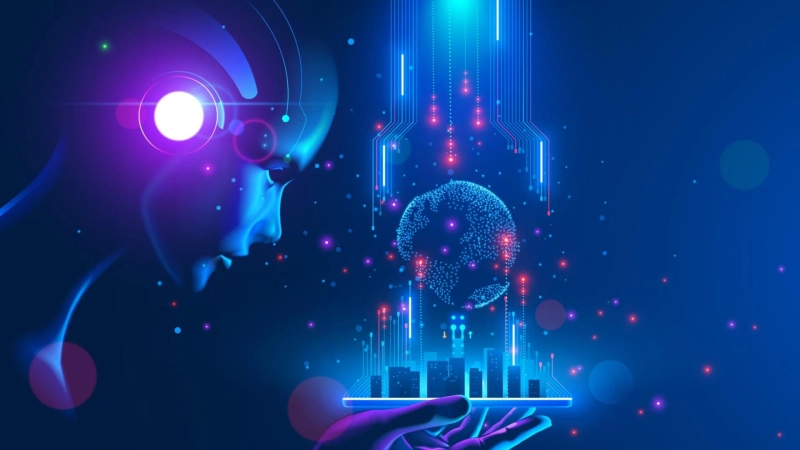One of the hottest social and technical issues right now is the metaverse. Combining different technologies such as Augmented Reality, Virtual Reality, blockchain development company and many others, companies are already working on creating services for this new digital world.
The concept of the metaverse was first coined by the writer Neal Stephenson in the early 1990s in his novel "Snow Crash" where it is presented as " an urban environment, developed around a single road 100 meters wide that completely travels the circumference of 65536 km (216 km) of a perfect sphere of black color, devoid of detail.”
One of the most recent views on the Metaverse is the one published by Coinbase, which borrows the definition from Matthew Ball:
The Internet of the future will be a sizable, permanent, interactive, and interoperable platform made up of connected virtual worlds where users may engage in social interaction, business transactions, gaming, and creative endeavours.
The metaverse is the far evolution of Web3. In its most comprehensive form, it would consist of a network of decentralized, interconnected virtual worlds with a working economy where individuals will be able to carry out nearly all activities currently possible in the real world.
Another very interesting vision is that of the CEO of Beamable, Jon Radoff, who has divided the metaverse into 7 layers: experience, discovery, creator economy, spatial computing, decentralization, human interface and infrastructure. Thus creating the concept of the Metaverse value chain, as shown below:
It is not difficult to find the presence of AI within these layers, thanks to machine learning (ML) algorithms and deep learning (DL) architectures. For example, many ML algorithms with supervised and unsupervised machine learning are applied in classification and regression models for speech recognition and other natural language processing (NLP) tasks that enable user understanding.
By fusing AI with other technologies, the metaverse can create secure, scalable, and realistic virtual worlds on a reliable, always-on platform.
Key applications of AI and the metaverse
In this section we are going to expose four of the key applications of AI: healthcare, manufacturing, smart cities and gaming.
Health Care
The healthcare industry has started to exploit some revolutionary techniques such as virtual reality and data embedding AI in software and hardware to increase the efficiency of medical devices, reduce the cost of healthcare services, improve operations and expand the scope of medical care.
Through virtual and extended reality systems, AI plays a fundamental role in many healthcare sectors, bringing considerable improvements in the following fields, for example:
Provide higher quality radiological images with real-time analysis. Get diagnoses faster to deliver more accurate medical decisions. Support the training of interns and doctors in the metaverse, thanks to the interactive simulation of complex operations.
Manufacturing
In the manufacturing industry, the design and implementation of optimal production lines is crucial to increase productivity and financial performance.
Today, many manufacturing plants have developed collaborative industrial robots to carry out different advanced tasks that require cognitive skills, intelligence, and human domain knowledge to immediately respond to unexpected actions or events with high precision and confidence. For this, a cooperative AI model is required to learn those complicated patterns from multimodal data for different process tasks, in which the AI model must have the ability to explain and reason.
In the metaverse, through virtual entities, industrial manufacturing efficiencies are generally improved to speed up production process design, encourage collaborative product development, reduce operational risk for quality control, and gain high reliability. Transparency both for the producer and for the final customers.
Smart cities (Smart Cities)
Smart cities acquire valuable information about the needs of citizens through the IoT, video cameras, social networks and other sources. Based on user feedback, city governments must make decisions about which services to remove, offer, and improve.
Using digital tools and pioneering technologies, smart cities provide intelligent interactive services to citizens through the metaverse, where data obtained from various sources is displayed in the virtual world with ease of use, such as: intelligent transportation systems (ITS). ), intelligent management systems for public lighting, automatic parking systems, intelligent community portals and indoor and outdoor video surveillance systems.
Currently, the real impact and benefit of these technologies for smart cities is limited; however, the metaverse can be an accelerator to spread the delivery of intelligent services into the daily lives of citizens. So designing and implementing the metaverse for smart cities with all administrative services such as environment, education, transportation, culture and other civil services is really a challenging mission for governments.
Video game
It is not possible to talk about the metaverse, without mentioning the video game industry, the spearhead of this technology. In the last decade, AI is redefining and revolutionizing this industry, having a huge impact on the way video games are developed. To build more realistic worlds with compelling challenges and unique storylines, game developers and studios turn to this technology as a powerful set of tools that help systems and NPCs respond to player action in dynamic and reasonable ways.
The use of AI in video games generates a lot of debate regarding the following topics:
AI-assisted storytelling. Strategy and learning of the behavior of the characters. Design of the interaction between the player and the NPC. Game tactics planning. Modeling of the player's response to certain situations.
Innovative algorithms in this market have brought an unprecedented revolution in the immersive experience of games: improving the intelligence of NPCs, modeling complex systems, creating spectacular and rational games, blockchain development company making interactions between humans and NPCs more realistic, reducing the cost of creating virtual environments and creating more powerful mobile game development opportunities.
In conclusion, with the help of artificial intelligence, a highway to the future is being built, with totally unpredictable prospects for technological, economic, cultural and social development, but which allow us to create beyond our physical habitat, an extraordinary metaverse where the limits for the development of human activity are inconceivable.


